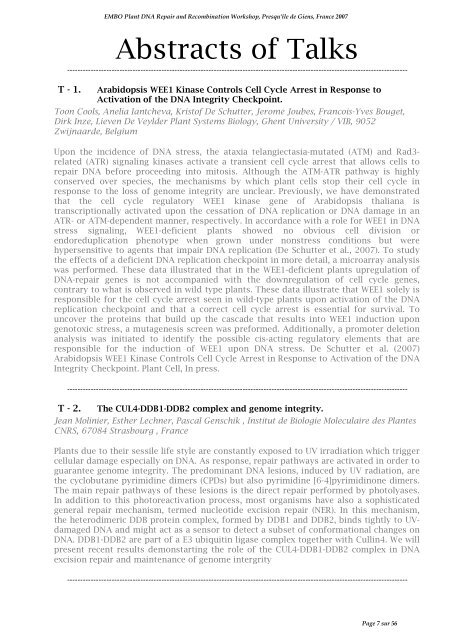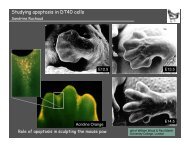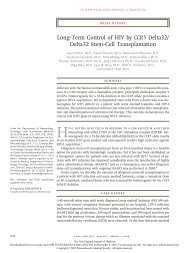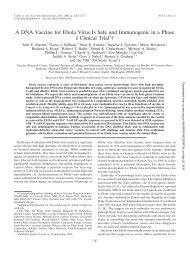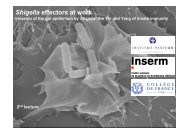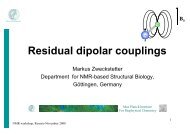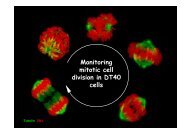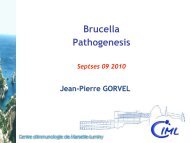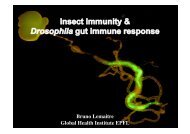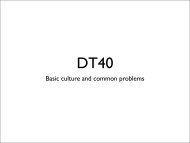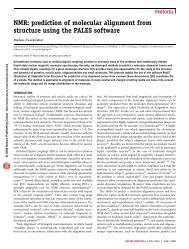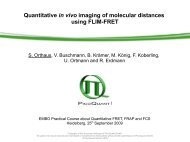pdf file - Events - EMBO
pdf file - Events - EMBO
pdf file - Events - EMBO
You also want an ePaper? Increase the reach of your titles
YUMPU automatically turns print PDFs into web optimized ePapers that Google loves.
<strong>EMBO</strong> Plant DNA Repair and Recombination Workshop, Presqu'île de Giens, France 2007<br />
Abstracts of Talks<br />
----------------------------------------------------------------------------------------------------------------------------------<br />
T - 1. Arabidopsis WEE1 Kinase Controls Cell Cycle Arrest in Response to<br />
Activation of the DNA Integrity Checkpoint.<br />
Toon Cools, Anelia Iantcheva, Kristof De Schutter, Jerome Joubes, Francois-Yves Bouget,<br />
Dirk Inze, Lieven De Veylder Plant Systems Biology, Ghent University / VIB, 9052<br />
Zwijnaarde, Belgium<br />
Upon the incidence of DNA stress, the ataxia telangiectasia-mutated (ATM) and Rad3related<br />
(ATR) signaling kinases activate a transient cell cycle arrest that allows cells to<br />
repair DNA before proceeding into mitosis. Although the ATM-ATR pathway is highly<br />
conserved over species, the mechanisms by which plant cells stop their cell cycle in<br />
response to the loss of genome integrity are unclear. Previously, we have demonstrated<br />
that the cell cycle regulatory WEE1 kinase gene of Arabidopsis thaliana is<br />
transcriptionally activated upon the cessation of DNA replication or DNA damage in an<br />
ATR- or ATM-dependent manner, respectively. In accordance with a role for WEE1 in DNA<br />
stress signaling, WEE1-deficient plants showed no obvious cell division or<br />
endoreduplication phenotype when grown under nonstress conditions but were<br />
hypersensitive to agents that impair DNA replication (De Schutter et al., 2007). To study<br />
the effects of a deficient DNA replication checkpoint in more detail, a microarray analysis<br />
was performed. These data illustrated that in the WEE1-deficient plants upregulation of<br />
DNA-repair genes is not accompanied with the downregulation of cell cycle genes,<br />
contrary to what is observed in wild type plants. These data illustrate that WEE1 solely is<br />
responsible for the cell cycle arrest seen in wild-type plants upon activation of the DNA<br />
replication checkpoint and that a correct cell cycle arrest is essential for survival. To<br />
uncover the proteins that build up the cascade that results into WEE1 induction upon<br />
genotoxic stress, a mutagenesis screen was preformed. Additionally, a promoter deletion<br />
analysis was initiated to identify the possible cis-acting regulatory elements that are<br />
responsible for the induction of WEE1 upon DNA stress. De Schutter et al. (2007)<br />
Arabidopsis WEE1 Kinase Controls Cell Cycle Arrest in Response to Activation of the DNA<br />
Integrity Checkpoint. Plant Cell, In press.<br />
----------------------------------------------------------------------------------------------------------------------------------<br />
T - 2. The CUL4-DDB1-DDB2 complex and genome integrity.<br />
Jean Molinier, Esther Lechner, Pascal Genschik , Institut de Biologie Moleculaire des Plantes<br />
CNRS, 67084 Strasbourg , France<br />
Plants due to their sessile life style are constantly exposed to UV irradiation which trigger<br />
cellular damage especially on DNA. As response, repair pathways are activated in order to<br />
guarantee genome integrity. The predominant DNA lesions, induced by UV radiation, are<br />
the cyclobutane pyrimidine dimers (CPDs) but also pyrimidine [6-4]pyrimidinone dimers.<br />
The main repair pathways of these lesions is the direct repair performed by photolyases.<br />
In addition to this photoreactivation process, most organisms have also a sophisticated<br />
general repair mechanism, termed nucleotide excision repair (NER). In this mechanism,<br />
the heterodimeric DDB protein complex, formed by DDB1 and DDB2, binds tightly to UVdamaged<br />
DNA and might act as a sensor to detect a subset of conformational changes on<br />
DNA. DDB1-DDB2 are part of a E3 ubiquitin ligase complex together with Cullin4. We will<br />
present recent results demonstarting the role of the CUL4-DDB1-DDB2 complex in DNA<br />
excision repair and maintenance of genome intergrity<br />
----------------------------------------------------------------------------------------------------------------------------------<br />
Page 7 sur 56


